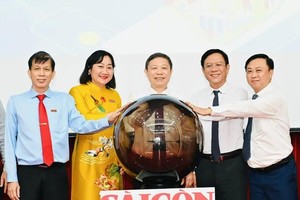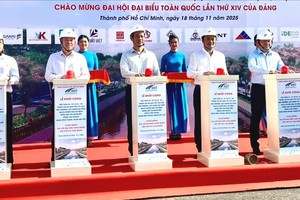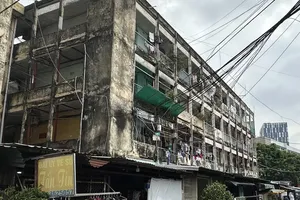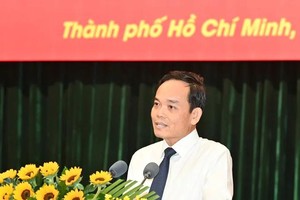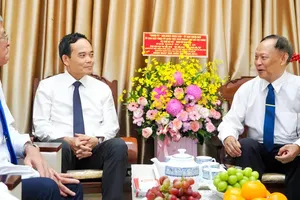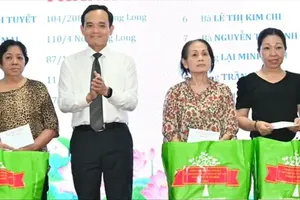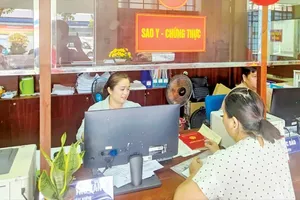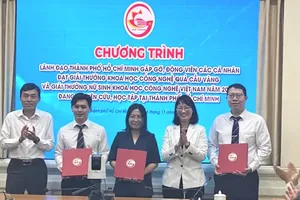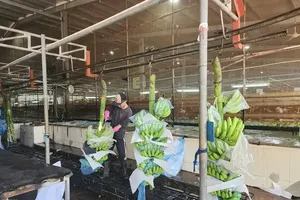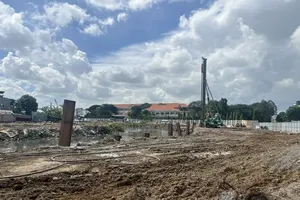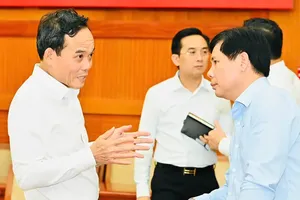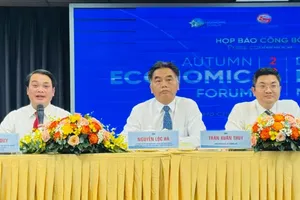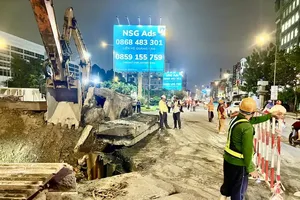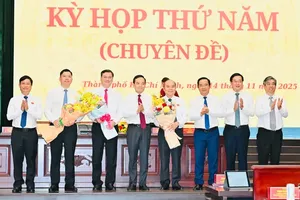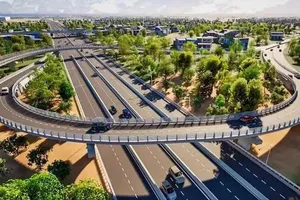 |
A CNG-powered bus runs on Ton Duc Thang Street in District 1. |
Ho Chi Minh City stands out as a leading city nationwide in investment in environmentally friendly public passenger transportation development. More than a decade ago, HCMC implemented various policies to support public passenger transport units in transitioning to eco-friendly buses. However, as of now, it appears that the situation is moving in a less optimistic direction.
The adoption of buses running on clean fuels, such as electric and compressed natural gas (CNG), is a commendable step in contributing to environmental conservation and cost efficiency. However, as of now, both the number of these buses and the level of investment from businesses remain relatively modest.
Various efforts
The initiative to develop environmentally friendly buses in HCMC started 13 years ago with the introduction of buses powered by CNG. In April 2010, Saigon Passenger Transport Company (SATRANCO) rolled out the first CNG-powered bus for a trial run in the city, operating on route No.10 from Mien Tay Bus Station to the Vietnam National University-HCMC dormitory. By the latter part of August 2011, SATRANCO continued to deploy 21 CNG-powered buses. In the subsequent year, various entities put an additional 28 CNG-powered buses into service on various routes.
These are CNG-powered buses operated by Quyet Thang Bus Cooperative on the Ben Thanh - Cho Lon Bus Station route, five eco-friendly buses from the HCMC Union of Transport Cooperatives running on An Suong Bus Station - Nong Lam University route, and 14 CNG-powered buses operated by Phuong Trang Company on the inter-provincial route connecting Mien Tay Bus Station to the Dai Nam Tourist Area in Binh Duong Province. Notably, the HCMC Union of Transport Cooperatives has two CNG-powered buses, specifically designed for people with disabilities, featuring fully automated operations. When approaching a station, the bus automatically adjusts its floor to be level with the roadside and then activates an automatic lift for easy boarding and disembarking for people with disabilities.
In line with the green and environmental protection criteria, HCMC introduced its first electric bus route in March 2022. The D4 electric bus route, serving the Vinhomes Grand Park - Saigon Bus Station route, is operated by VinBus Company. Despite being a late addition, the D4 electric bus route boasts the advantage of covering areas that were previously underserved by buses. Additionally, it passes through numerous passenger-attractive locations, such as Saigon High-Tech Park, schools, residential areas, and the People's Committee of Thu Duc City.
The passenger traffic on the D4 electric bus route has been steadily growing since its commencement. Specifically, the average passenger count in the initial year was around 23 passengers per trip, and this figure has increased to 33 passengers per trip as of the first ten months of 2023. According to the leadership of the Public Transportation Management Center under the Department of Transport of HCMC, D4 electric bus route is one of the routes with a notably high average passenger load per trip within the city's subsidized bus system.
In practice, investing in eco-friendly buses not only plays a role in environmental conservation but also leads to substantial cost savings. According to Mr. Phung Dang Hai, Chairman of the Board of Directors of the HCMC Union of Transport Cooperatives, from the acquisition of the first CNG-powered bus, the union has committed to systematically replacing the entire fleet of diesel buses with buses using clean fuels because the benefits are evident with a reduction in environmental pollution and a 30 percent fuel saving compared to diesel-powered buses.
From the city's perspective, the HCMC Department of Transport pays special attention to the technical standards for the bus investment plan until 2030 and beyond. The focus is on the development of electric and CNG-powered buses, with the stipulation that newly invested vehicles must meet emission standards from Euro 3 and above.
Mr. Vo Khanh Hung, Deputy Director of the HCMC Department of Transport, shared that the department has submitted a report and proposed a synchronous legal framework for the development of green transportation to mobilize and leverage social resources, swiftly advance towards fulfilling commitments related to climate change adaptation, and align with the government's goal of achieving zero emissions by 2050.
The Department of Transport also suggests investing in a charging station system and infrastructure to support the maintenance of vehicles using clean fuels, alongside the development of environmentally friendly fuel buses. In the coming period, the Department of Transport will actively collaborate with the Transportation Works Construction Investment Project Management Authority of HCMC to provide input on relevant legal foundations, including norms and prices for buses using clean fuels. These inputs will serve as the basis for budget estimation in the bidding process.
Anxiously awaiting support
According to the latest statistics from the HCMC Department of Transport, the entire city currently boasts 496 CNG-powered vehicles across 17 subsidized routes managed by six businesses, including May 19 Cooperative with 158 vehicles, Cooperative 28, Quyet Thang Cooperative with 84 vehicles, the HCMC Union of Transport Cooperatives, and Saigon Passenger Transport Company with 128 vehicles. With 496 CNG-powered buses out of 2,046 total passenger transportation vehicles by buses, accounting for just over 24 percent of the total, this figure is considered fairly modest, according to expert assessments.
Moreover, to fuel the CNG-powered buses, there are currently only three refueling stations situated at An Suong Bus Station, the bus yard on Pho Quang Street in Tan Binh District, and the bus yard at the Vietnam National University - HCMC in Thu Duc City. With a daily demand for clean fuel amounting to 40 tons of CNG, the number of refueling stations is not only limited but is also located on the city outskirts, resulting in additional transportation costs for refueling for transport businesses.
In particular, buses operating on route No.32, from Mien Tay Bus Station to Ga Crossroads Bus Station, are required to cover approximately 10 km daily from the Ga Crossroads Bus Station to An Suong Bus Station exclusively for CNG refueling, leading to extra expenses. Despite numerous appeals and petitions to the authorities by CNG bus operators, the matter remains unresolved as of now.
 |
An electric bus commutes on Mai Chi Tho Street in Thu Duc City, HCMC. |
On the other hand, the city's first electric bus route is encountering different difficulties. Leaders at VinBus Company revealed that, despite an increase in passenger numbers, the revenue fails to cover the expenses due to the exceptionally low subsidy rate for the D4 electric bus route-just over 44 percent, a figure lower than the subsidy rates for CNG and diesel-powered buses which currently hover around 65 percent.
It is the primary factor preventing VinBus Company from proceeding with the planned expansion of four additional electric bus routes. According to Mr. Phung Dang Hai, Chairman of the Board of Directors of the HCMC Union of Transport Cooperatives, any additional investment in CNG-powered buses, or a comprehensive shift of the city's bus fleet to clean-fuel buses, unequivocally requires substantial support from the government through more appropriate and tailored policies.
Fierce competition by app-based ride-hailing services
In recent years, the public bus transportation sector has been facing fierce competition. Consequently, the number of bus passengers has seen a continuous decline. The decline is not due to reduced travel demand but rather a shift to alternative transportation modes, combined with various other factors.
With just a few taps on a smartphone-a device now popular among city residents, one can quickly and easily summon a technology-driven ride-hailing service. Furthermore, many people perceive the advantages of technology-driven rides as being picked up and dropped off at specific locations, a convenience that buses cannot provide. Another notable advantage is the flexibility of technology-driven rides in navigating traffic congestion or roadblocks.
Policies to foster green transportation needed
In the prevailing economic difficulties, HCMC needs a detailed roadmap and policies to support green transportation. Over the next five years, the city should concentrate on robust support for CNG-powered buses, given their more cost-effective nature compared to electric buses. The cost of a CNG bus, accommodating 80 seated and standing passengers, is slightly over VND2 billion per bus, whereas an electric bus comes with a price tag of around VND7 billion per bus.
Moreover, over a decade ago, the HCMC People's Committee entrusted Saigon Transportation Mechanical Corporation, a State-owned enterprise, with the investment in manufacturing CNG buses, indicating an established source of supply. The next crucial step for CNG-powered buses is the city's investment in additional gas refueling stations. This could involve collaboration with gas supply companies. In the subsequent phase, as the economy recovers, the city will substantially invest in electric buses. Similar to CNG-powered buses, beyond vehicle investment, the city must also plan for the investment in electric charging stations.
Above all, beyond the financial support for green transportation from the budget, the city should adopt additional policies to attract non-budgetary capital, such as advertising on buses, for instance. Although HCMC already has policies to attract this form of funding, the implementation has not met the intended effectiveness. It might be prudent to consider an adjustment, allocating a reasonable share of the revenue generated from this source to transportation companies. This allocation would not only aid businesses in covering extra vehicle maintenance costs but also reinforce their responsibility for maintaining the advertising images on the buses.
In addition to investing in vehicles and technical infrastructure for public transportation in general and green public transportation in particular, HCMC should also formulate a strategy to invest in communication programs to attract passengers to opt for public transportation instead of private vehicles.
By Mr. Le Trung Tin, Chairman of HCMC Passenger Transport Association
- Translated by Thuy Doan
